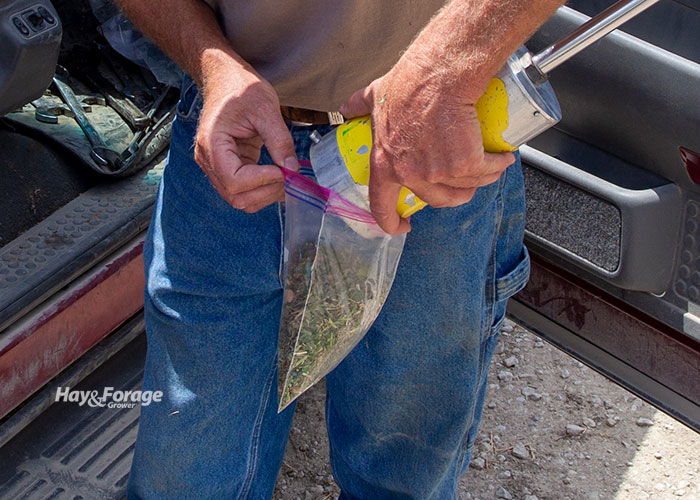
If you grow or harvest forage, develop forage products, sell stuff to people who grow forage, educate people who grow forage, do research for people who grow forage, or just buy forage, then consider yourself a card-carrying member of the forage industry.
Wherever you fit into this unique band of brothers and sisters often helps form your opinions on a variety of forage topics and issues. Sometimes, those opinions differ. I could pick any number of topics to demonstrate this, but let’s focus on forage testing and analysis. First, some full disclosure on my part.
My past has long been grounded in forage crops, but specifically as they are produced and utilized in the Midwest dairy industry. That is probably still my measuring stick, although in my current journalistic endeavors I have had the opportunity to interact with many other types of forage and livestock producers from across the United States.
Forage testing, or more specifically fiber analysis, propelled dairy production to heights that didn’t seem possible 50 years ago. Of course, this required both advancements in analytical protocols and the knowledge of how to use the results for ration formulation. Although this knowledge base is still evolving, nearly all dairy farmers and their nutritionists embrace routine forage testing like they accept the fact that underwear goes on before the pants.
The routine use of forage analysis in the dairy industry has been in place for many years. Dairy farmers from across the U.S. generally don’t make or purchase feed unless it is tested. It’s unlikely that you’d ever go to a dairy conference and hear some extension specialist trying to convince the audience that they need to test their forages; that’s because they already are, and in many cases, multiple times per month. Milk doesn’t get made without high-quality forages. Further, most hay producers who sell to dairy farmers know that forage test results need to come with the sale.
Middle ground
It’s an easy determination that the beef industry occupies the forage testing middle ground, or at least that’s true for the cow-calf operations. Some operators can readily produce forage test results for their hay or baleage, while many others just shrug and indicate that they haven’t seen a need to test. Even when purchasing hay, many beef producers won’t require an accompanying forage test.
Unlike dairy educational events, there is still plenty of discussion on the benefits of forage testing at cow-calf conferences. This reaffirms my observation that there’s still ample room for improvement.
Forage test results can but don’t necessarily tell you what to feed; however, they will tell you what you are feeding. That seems equally important for a beef cow as it does for a dairy cow.
Although it’s true that beef nutrient demands are lower than for dairy, those demands must still be met. That might be easy to do on spring and early summer pastures, but it’s a different conversation when cows are calving in February and stored forage is the primary feed source. Not just any forage will do when a cow is making milk or a stocker needs to gain weight.
Beef nutrition research is clear that there’s a fine balance between protein and energy at various stages of a cow’s reproductive life. The only way to tip the economic balance in your favor is to forage test. Also, many beef producers are learning that high-quality hay or baleage makes for an economical supplemental feed when limit fed. Such a strategy keeps the feed store invoice a bit more manageable.
The guessers
That brings us to the third major forage consumer and buyer — horses and their owners. Based on my observations, a forage test is of little interest to the latter, or at least the vast majority.
I make this statement not because I have had extensive interactions with horse owners, although I’ve had some, but rather on my familiarity with hay producers who sell their wares into the horse market. Some of these haymakers make tens of thousands of small square bales in any given year.
When asked, “Do you test all of your hay?," the answer is almost always something similar to “My customers don’t care about or understand a forage test; they only care about looks and smell.”
So, for horses, I guess that eliminates all of the good hay that may not look the best and brings into play all the poor-quality hay that might look really good. Both of those products are haymaking realities.
I don’t know of any equine specialist who readily supports the concept of not testing hay. In fact, it’s just the opposite. Horses can have an array of metabolic issues, most of which are caused by diet. Many forage testing labs have special forage tests for horses, so it’s not like the industry isn’t ready and waiting. The problem is that most horse owners, including both large and small operations, are unwilling to test their forages or remain unaware of the benefits of forage analysis.
Fertile ground remains
The availability of forage testing labs has ballooned in recent years, and new tests become available with each passing year. It’s a lab’s job to provide the most accurate analysis available; it’s on the submitter to provide the most representative sample(s) possible. Each year, millions of dollars ride on decisions made from forage test analyses.
There is still much more opportunity to use and improve forage tests. The dairy industry is getting close, but the beef and equine industries, generally speaking, can do much better.

